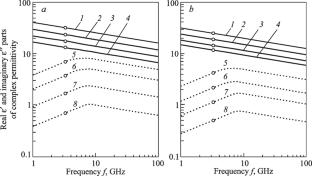The dependences of the real and imaginary parts of complex permittivity in AlN–SiC composites, with a silicon carbide content ranging from 20 to 50%, are characterized over a frequency range of 1–100 GHz. The SiC particles have average sizes of 0.8 and 2.3 μm. As the frequency increases from 1 to 100 GHz, the general trend shows a consistent decrease in the real part ε′ in inverse proportion to the frequency raised to the 1/5 power. The imaginary part ε″ first increases in direct proportion to the frequency raised to the 1/2 power when the frequency raises from 1 to 3 GHz, reaches its maximum in the 6–8 GHz range, and then monotonically decreases in inverse proportion to the frequency raised to the 1/5 power at frequencies greater than 8 GHz. Throughout the entire frequency range, ε′ and ε″ are found to be frequency-dependent. However, at frequencies above 8 GHz, the ε″ / ε′ = tgδ ratio remains constant and is not frequency-dependent. Analytical expressions are proposed for these dependences, allowing ε′ and ε″ to be calculated at any frequency within this range. To plot these dependencies, at least one experimental data point with reliable ε′ and ε″ values should be obtained, preferably between 2 and 5 GHz. This is particularly important for ε″, as it changes uniquely over the 1–10 GHz frequency range. To specify ε″ values at frequencies below 8 GHz, two methods are proposed. The first method employs geometric construction of the inscribed circle for ε″ as a function of frequency, enabling rapid determination of ε″ in the 4–8 GHz frequency range for AlN–SiC composites containing 20 to 50% SiC. The maximum deviation from true ε″ does not exceed 3%. The second method involves calculated parabolas, also inscribed in the frequency dependence of ε″. Over the 6–8 GHz range, the deviation of ε″ does not exceed 3% for SiC contents below 40%.



